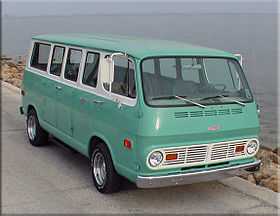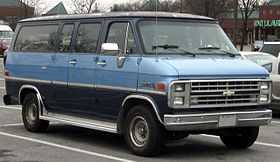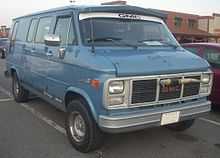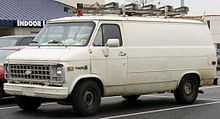Chevrolet Van
| Chevrolet/GMC Van | |
|---|---|
 | |
| Overview | |
| Manufacturer | General Motors |
| Production | 1964–1996 |
| Body and chassis | |
| Body style | van |
| Chronology | |
| Predecessor | Chevrolet Greenbrier Sportswagon |
| Successor | Chevrolet Express / GMC Savana |
- This page talks about the 1964–1996 Chevrolet Van and GMC Vandura. For the post-1996 successor, see Chevrolet Express.
The Chevrolet and GMC G-Series vans were made by General Motors for North America. They are in the same vehicle class as the Ford Econoline van and the now discontinued Dodge Ram Van.
The term "Chevrolet van" also refers to the entire series of vans sold by Chevrolet. The first Chevrolet van was released in 1961 on the Corvair platform, and the latest Chevrolet van in production is the Chevrolet Express.
The G20 and its counterparts replaced the original Chevrolet Corvair Greenbrier Van in the late 60s the model line evolved until it was replaced in 1996 by the Chevrolet Express. 1964-70 G20s came with six-lug wheels (6 lugs - 5.5" (139.6 mm) bolt circle), while the 1971-96 generation came with the 5 lug - 5" (127 mm) bolt circle.
G20s were fitted with the ball joints from the Chevrolet/GMC 3/4 and 1 ton pickups although using the 1/2 ton pickup's brake rotors.
A light duty version, the G10, was produced alongside the G20 - the early versions used the Chevrolet passenger car wheels (5 lugs - 4.75" (120.7 mm) bolt circle) until 1975 (G10s manufactured prior to the 1976 model year had the smaller bolt pattern, common with the short wheelbase vans), yet can still handle LT tire sizes for better handling and stability. The G20 series sported an SB 262 4.3L engine, not much was changed mechanically in the vehicles since their release, other than carburettor to a throttle body injection fuel system, and less use of a vacuum system. Currently there are more after market part options available for its V8 counterparts. Not much has been done in the lines of performance options for the small V6 G20 models, but the reliability remains the same throughout all the G-series models.
The G20's low cost of upkeep, size, and options have made this van popular with all different kinds of trades, from plumbers to caterers.
First generation (1964–1966)
| First Generation | |
|---|---|
 | |
| Overview | |
| Manufacturer | General Motors |
| Also called |
Chevrolet Sportvan GMC Handi-Van GMC Handi-Bus |
| Production | 1964–1966 |
| Assembly | Pontiac, MI, United States |
| Body and chassis | |
| Class | Compact van |
| Body style | 3+1 door van |
| Layout | FMR layout |
| Powertrain | |
| Engine |
153 cu in (2.5 L) I4 194 cu in (3.2 L) I6 230 cu in (3.8 L) I6 |
| Dimensions | |
| Wheelbase | SWB: 2,286 mm (90.0 in) |
The first General Motors van was the Chevrolet Corvair-based Chevrolet Greenbrier van, or CorVan introduced for 1961, which used a flat-6 opposed rear engine with air cooling, inspired by the Volkswagen bus. Production of the Chevrolet Greenbrier ended during the 1965 model year.
The 1st generation ChevyVan refers to the first Chevrolet G-Series vans G-10 1⁄2 ton production years 1964 through 1966. General Motors saw a market for a compact van based on a modified passenger car platform to compete with the already successful Ford Econoline and Dodge A100. The 1964 ChevyVan had a cab forward design with the engine was placed in a "doghouse" between and behind the front seats. The implementation of situating the driver on top of the front axle with the engine near the front wheels is called internationally a "cab over" vehicle. Engines and brakes were sourced from the Chevy II, a more conventional compact car than Chevrolet Corvair. The forward engine design allowed a flat rear floor with low deck heights in the rear of the van for loading/unloading cargo. This model was also sold by GMC as Handi-Van. The 1st Gen vans were available in only the short 90-inch wheelbase and were only sold with the standard 90 hp 153-cubic-inch straight-4 or Chevrolet Straight-6 engine. A first gen is quickly identified by its single piece flat windshield glass. The first 1964 ChevyVan was originally marketed and sold as a panel van for purely utilitarian purposes. Windows were available as an option, but were simply cut into the sides from the factory. In 1965, Chevy added Sportvan which featured windows actually integrated into the body. GMC marketed their window van as Handi-Bus. Air conditioning, power steering and power brakes were not available in the 1st generation vans.
Updates
1964
The original "classic" flat windshield van. The 90 hp (67 kW) 153 cu in (2.51 L) four-cylinder engine was standard equipment with optional 120 hp (89 kW) 194 cu in (3.18 L) Chevrolet Straight-6 engine available. The straightforward construction and a boxy design was ideal for economically hauling cargo, tools and equipment around town. The base cargo model was the ChevyVan, available with or without windows and side cargo doors. Even the heater and right front passenger seat were optional. The Warner 3-speed manual transmission was standard with column shift. A 2-speed Powerglide automatic transmission was available as an option.
1965
For 1965, the van remained largely unchanged. The grille openings were widened, and received one additional slot just above the bumper to increase cooling. Seat belts were added. The exciting news for the 1965 model year was the introduction of the Chevy Sportvan and GMC Handi-Bus. Sportvan was a passenger friendly van with windows molded into the van body. A retractable rear courtesy step for the passenger side doors was used on the Sportvan. The 194 6-cylinder engine was now standard equipment, with an available 'Hi-Torque' 140 hp (100 kW) 230 cu in (3.8 L) six-cylinder
1966
This was the last year of the flat glass front end on the Chevy Vans. Changes for 1966 include the addition of back-up lights, the side ChevyVan emblems were moved forward and now mounted on the front doors, and the antennae location was moved from passenger side to driver side. The base model "Sportvan" now had two additional trim packages available: Sportvan Custom and Sportvan Deluxe. These featured available upgrades such as Chrome bumpers, two tone paint, rear passenger seats, interior paneling, padded dash, chrome horn ring.
Second generation (1967–1970)
| Second generation | |
|---|---|
 | |
| Overview | |
| Manufacturer | General Motors |
| Also called |
Chevrolet Sportvan GMC Handi-Van GMC Handi-Bus |
| Production | 1967–1970 |
| Assembly | Pontiac, MI, United States |
| Body and chassis | |
| Class | Van |
| Body style | 3+1 door van |
| Layout | FMR layout |
| Powertrain | |
| Engine |
230 cu in (3.8 L) I6 250 cu in (4.1 L) I6 283 cu in (4.6 L) V8 307 cu in (5.0 L) V8 350 cu in (5.7 L) V8 |
| Dimensions | |
| Wheelbase |
SWB: 2,286 mm (90.0 in) LWB: 2,743 mm (108.0 in) |
In 1967, ChevyVan received a major facelift, including moving the headlights down to a new redesigned grille, larger, rectangular tail lights and a curved windshield. The forward control cab design was retained, but the doghouse was lengthened, widened and slightly relocated in order to fit an optional Chevrolet Small-Block engine. Engine cooling was improved with the addition of an optional larger cross-flow type radiator and a redesigned front which included a low-profile tunnel allowing more fresh air to the radiator. The 2nd gen vans were available in either the 90-inch or the longer 108-inch wheelbase. Power steering and "conventional" air conditioning (with dash vents & controls) were never available on the second-generation van.
1967
1967 begins the "Second Generation" ChevyVan with a whole new look to the van and offering a longer 108" wheelbase and V8 power to buyers for the first time. GM designers moved the headlights down to a new grille, added longer, rectangular tail lights and a rounded glass windshield. 1967 was the only early 2nd generation that did not have side marker lights. The forward control cab design was retained, but the doghouse was widened and lengthened in order to fit the optional V8 Chevrolet Small-Block engine. Engine cooling was improved with redesigned doghouse, the addition of a larger optional cross-flow type radiator and a redesigned front floor tunnel more fresh air to the radiator. The 2nd gen G-10 vans were available in the original short wheelbase 90 inches (2,286 mm) or the new optional long wheelbase 108-inch (2,743 mm) with 5 on 4&3/4" lug bolt pattern. Another feature in 1967 was the availability of a new G-20 heavy duty 3/4 ton van. The G-20 featured heavier suspension, a 12 bolt rear axle and increased hauling capability with a 6 lug bolt pattern. The G-20 model was available only on the 108 long wheelbase. For 1967, the 140 hp (100 kW) 230 cu in (3.8 L) six-cylinder was now standard, with the optional 155 hp (116 kW) 250 cu in (4.1 L) six-cylinder or the 175 hp, 283 cu in (4.64 L) 2-barrel, V8. Brakes were now upgraded to a safer split system including a dual reservoir master cylinder.
1968
This was the first year that Chevy Vans had side-marker lights, mandated by federal government regulations. The front lights were located towards the front in the middle of the front doors, while the rear marker lights were located about a foot inward of the very back edge just below the vertical middle of the van.
The optional V-8 engine was upgraded from the 283 2-barrel (175 HP) to the larger, more powerful 307 2-barrel V8 (200 HP @ 4600 rpm).
A column shift 4-speed transmission (Warner T10) was now available as an option.
the mystery machine was not based on the chevy van. the mystery machine had a bench seat in the front. the only vans built with that configuration were the VW bus and the corvair van.
1969
For the 1969 model year, the 3-speed TH-350 Turbo-Hydramatic automatic transmission and optional power brakes were now available. "Body-integrated" air conditioning was available on 1969 Sportvan models. This was not your typical AC setup with dash vents and controls, but rather a roof-mounted unit with a single blower duct that had adjustable louvers to direct air flow. Up front, the Chevrolet bowtie emblem changed in color from red to blue this year.
1970
1970 was the last year of the square styling, front drum brakes, and I-beam front axle. The 250 CID 6-cylinder (155Hp @ 4200 rpm) was now standard equipment. In addition to the 307-2-barrel V-8, a 350-4-barrel (255 HP @ 4600 rpm) V-8 engine was available as an option for the first time in 1970. The 3-speed automatic and manual 4-speed column shift continued to be available as transmission options.
Third generation (1971–1996)
| Third generation | |
|---|---|
 | |
| Overview | |
| Manufacturer | General Motors |
| Also called |
Chevrolet Beauville Chevrolet G-Series Chevrolet Sport Van GMC Rally Wagon GMC Vandura |
| Production | 1971–1996 |
| Assembly |
Lordstown, Ohio, United States Flint, Michigan, United States Scarborough, Ontario, Canada |
| Body and chassis | |
| Class | Full-size van |
| Body style |
3-door van 3+1 door wagon 4-door van |
| Layout | Front-engine, rear-wheel drive / four-wheel drive |
| Related | Chevrolet/GMC C/K |
| Powertrain | |
| Engine |
4.1L I6 4.3L V6 5.0L V8 5.7L V8 7.4L V8 6.2L diesel V8 (1982–93) 6.5L diesel V8 (1994–95) |
| Transmission |
3-speed automatic 4-speed automatic 4-speed manual |
| Dimensions | |
| Wheelbase |
110 in (2,794 mm) (SWB) 125 in (3,175 mm) (LWB) 146 in (3,708 mm) (EWB) |
| Length |
178.2 in (4,526 mm) (SWB) 202.2 in (5,136 mm) (LWB) 223.2 in (5,669 mm) (EWB) |
| Width | 79.5 in (2,019 mm) |
| Height |
79.4 in (2,017 mm) (SWB) 79.2 in (2,012 mm) (LWB) 79.8 in (2,027 mm) (SWB) 81.9 in (2,080 mm) (LWB) |

In 1971, ChevyVan received a major redesign, moving the engine forward of the driver with a short nose and hood. The van was constructed of a unibody style frame and employed stronger truck style hubs and brakes with dual A-Arm independent front suspension. The major restyle followed the engine-forward design of the competing 1968 Ford Econoline. Suspension and steering parts came from the Chevrolet/GMC C-series pickup trucks. GMC now marketed their vans under the VanDura name. These models between 78 and 96 were popular with Van conversions such as Curtis and Starcraft. In addition to the cab-chassis models, there were also factory cube vans from Chevy and GMC, called the Chevy High-Cube or Hi-Cube, and GMC MagnaVan.
For 1997, the Chevrolet and GMC vans were replaced with the next-generation Chevrolet Express and GMC Savana with more aerodynamic styling. These vans were built on a stronger truck frame versus the previous generation's unibody construction. A left-side door was made available for the declining passenger van market.
Engines
The G20 passenger van came standard with a 4.1-liter L6 (135 hp (101 kW) and 235 lb·ft (319 N·m) @2400 rpm). The G20 could also have an L05 engine, which was a 5.7-liter V8 (190 hp (142 kW) @ 3600 rpm, 300 lb·ft (407 N·m) @ 2400 rpm). A 7.4-liter V8 (230 hp (172 kW), 385 lb·ft (522 N·m) @2400 rpm) was exclusive to the G30. The transmission choices were a four-speed automatic or a four-speed manual. Chevrolet also offered, in 1982–1995, the Detroit Diesel V8 engine and 5.0-liter V8 (150 hp (110 kW), 247 lb·ft (326 N·m) @2400 rpm)
Updates
1971
All new bodystyle was introduced this year, which continued until the end of the 1996 model year.
The Vandura and sister ChevyVan replaced the earlier flat nosed model. The GMCs were introduced in April 1970; interior components such as the steering column and steering wheel were sourced from the Chevrolet/GMC C/K pickups. The short wheelbase vans measured 110 inches (2,794 mm), while the long wheelbase was 125-inch (3,175 mm) wheelbase. Clear blinker housings were used on early models, along with blue grille ornaments Chevrolet models.
1973
For 1973, the dashboard was redesigned, steering wheel and side fender badges became similar to that used on the new for 1973 pickups and the Chevrolet bowtie grille emblem was changed from blue to yellow.
In these 73-77 Chevy Van years you could order a custom van of your dreams, complete with shag carpet and side pipe exhaust from the comfort of the Chevrolet dealership, through a company called "Van-Tastic" owned by Hop Cap Inc. in Bremen, Indiana. During the same period, GMC offered cutaway versions called the MagnaVan, while Chevrolet offered a similar version called the "Hi-Cube Van."
1978

The front sheetmetal was updated. Changes include: a new, built-out plastic grille with integrated blinkers, different fenders, round headlamps on lower-end models and square headlamps on higher-end models, and another new dash. Front and rear bumpers were enlarged.Chrome grille required square headlamps.
1980
All 1980 vans were given new rear-view mirrors on the driver and passenger doors. Some models got electronic spark control.
1981

Chevrolet offers Bonaventure trim for 1981 and 82 with chrome bumpers, chrome side marker lights and trim around the tail lamps. Also, the only G series vans that had chrome grille and round headlamps from the factory. Any other G van with a chrome grille from 1978-1982 required the rectangular headlamp option.
1982
For 1982, the locking steering column was introduced; the ignition switch, dimmer switch and wiper switch were relocated to the steering column. After 1982, 3-speed manuals would be relocated to the floor and base models will no longer have round headlamps, which would make Manual Transmission 1982 G vans rare and collectable as 1982 was the only model year with column shift manual transmission and ignition switch on the steering column. Also, 1982 was the only year with the left rear glass as an option on one side only.
1983
The 6.2 diesel was first available and Stacked 4-headlights introduced, alongside with a revised grille. Base models continued with 2 headlights. All van models now have square headlamps. From this model year on, tilt steering was available with a manual transmission because the steering column was retilted to be similar to the C/K trucks and all manual transmission levers are now on the floor. New steering wheels were introduced as well to be similar to the Monte Carlo/Malibu. Automatic overdrive introduced. 4-speed manual 117M transmission introduced.
This version was made famous by the American television series The A-Team.
1984
New swing-out side doors were introduced to go with the standard sliding side door. The doors were a 60/40 split. Last year for chrome trim side marker lamps and chrome trim around tail lamps options.
1985
The taillight and side marker lenses were redesigned. New Grille Treatment similar to the pickups.
1986/87
Most engines are fuel-injected and a 4.3-liter V6 replaces the old 4.1-liter inline six 115 hp. Diesel engine 6.2 is available in 165 hp. A carbureted 5.0-liter 190 hp V8 engine (option LE9) was also available in the 49-state version, with fuel injection for California-emission vehicles.
1989
introduced TBI 454 C.I. G30
1990
Unlike the Dodge Ram and Ford Econoline vans which had a welded-on body extension, a 146-inch (3,708 mm) extended wheelbase [1] was introduced (about the same length as a Chevrolet/GMC crewcab truck). This was done to accommodate an extra bench seat, finally giving GM a 15 passenger van. GM was the last American automaker to produce such a van, with Dodge introducing the genre in 1971 and Ford joining them in 1978.
1992

Facelift using the front grille from the former Chevrolet/GMC R/V series pickups and SUVs (Blazer, Suburban, Crew Cab/Dually), previously phased out of production in 1991. G30 models getting 4L80E transmission as standard.
1993
The 4L80E/4L60E automatic transmission was introduced, replacing the TH400/TH700R4. Brake-shift interlock is a standard, new-for-1993 feature, which requires the brake pedal to be depressed in order to shift from park. A 4-wheel antilock brake system is also a standard, new-for-1993 feature.
1994
A driver's side airbag and center high mount stop lamp were made standard, as well as CFC-free refrigerant in models equipped with air-conditioning.
1995
A new longer nose and four head light design was introduced (similar to the C/K of the same era), a very popular school bus conversion. The engine also received a facelift, with the 4.3L V6 now labeled the "Vortec". Engine sizes remained fairly the same e.g. 4.3L, 5.7L, 7.4L engines. Several versions of the van were available for purchase depending on the buyer's needs. Base model was basically a stripped down model - no frills, very limited interior and no rear seats. The "Sportvan" had all the features of a full conversion van, but no rear seats and no fiberglass roof extension. Then finally, the "Conversion" models were sent from the factory bare-bones, to have the interior and exterior upgrades added by third-party companies such as "Mark III, Tiara, Coach, Starcraft, etc."
1996
This year was essentially carryover from 1995. The 1996 G20 conversion van was an echo of the first generation G20.
Concept Vehicles
In 1966, General Motors developed the concept vehicle Electrovan, based on the GMC Handi-Van. The vehicle used a Union Carbide cryogenic fuel cell to power a 115-horsepower electric motor. It never went into production due to cost issues and safety concerns.[2]
References
- ↑ "1990 Chevy Van/Vandura" (PDF). https://www.gmheritagecenter.com''. GM Heritage Center. Retrieved 26 November 2014.
- ↑ "Private Sector; An Electrovan, Not an Edsel". Nytimes.com. 2002-11-17. Retrieved 2011-08-06.
- Mellon, Thomas A., Chevrolet, GMC 1/2, 3/4, 1 Ton Van Repair & Service Manual 1967–1986, Chilton's manual
- Hall, Douglas Kent: VAN PEOPLE: THE GREAT AMERICAN RAINBOW BOOGIE New York, T.Y. Crowell, 1977
External links
| Wikimedia Commons has media related to Chevrolet Van. |
- The first fuel cell vehicle was built from a Chevrolet Van in 1966
- The A-Team Van
- 1977 GMC Trucks Brochure (Old Car Brochures)
| Chevrolet, a marque of General Motors, light truck timeline, international market, 1950s–1970s — next » | ||||||||||||||||||||||||||||||
|---|---|---|---|---|---|---|---|---|---|---|---|---|---|---|---|---|---|---|---|---|---|---|---|---|---|---|---|---|---|---|
| Type | 1950s | 1960s | 1970s | |||||||||||||||||||||||||||
| 0 | 1 | 2 | 3 | 4 | 5 | 6 | 7 | 8 | 9 | 0 | 1 | 2 | 3 | 4 | 5 | 6 | 7 | 8 | 9 | 0 | 1 | 2 | 3 | 4 | 5 | 6 | 7 | 8 | 9 | |
| Full-size SUV | Veraneio | |||||||||||||||||||||||||||||
| K5 Blazer | K5 Blazer | |||||||||||||||||||||||||||||
| Suburban | Suburban | Suburban | Suburban | Suburban | ||||||||||||||||||||||||||
| Coupe utility | El Camino | El Camino | El Camino | El Camino | El Camino | |||||||||||||||||||||||||
| Compact pickup | LUV | |||||||||||||||||||||||||||||
| Full-size pickup | El Toro | |||||||||||||||||||||||||||||
| Advance Design | Task Force | C/K | C/K | C/K | ||||||||||||||||||||||||||
| Van | Van | Van | Van | |||||||||||||||||||||||||||
| Greenbrier | SportVan | SportVan | Beauville | |||||||||||||||||||||||||||
| GMC, a marque of General Motors, light truck timeline, United States and Canadian market, 1980s–present | ||||||||||||||||||||||||||||||||||||
|---|---|---|---|---|---|---|---|---|---|---|---|---|---|---|---|---|---|---|---|---|---|---|---|---|---|---|---|---|---|---|---|---|---|---|---|---|
| Type | 1980s | 1990s | 2000s | 2010s | ||||||||||||||||||||||||||||||||
| 0 | 1 | 2 | 3 | 4 | 5 | 6 | 7 | 8 | 9 | 0 | 1 | 2 | 3 | 4 | 5 | 6 | 7 | 8 | 9 | 0 | 1 | 2 | 3 | 4 | 5 | 6 | 7 | 8 | 9 | 0 | 1 | 2 | 3 | 4 | 5 | |
| Mid-size crossover | Terrain | |||||||||||||||||||||||||||||||||||
| Full-size crossover | Acadia | |||||||||||||||||||||||||||||||||||
| Compact SUV | Tracker | |||||||||||||||||||||||||||||||||||
| Mid-size SUV | S-15 Jimmy | Jimmy | Envoy | |||||||||||||||||||||||||||||||||
| Typhoon | ||||||||||||||||||||||||||||||||||||
| Full-size SUV | K5 Jimmy | Yukon | Yukon | Yukon | Yukon | |||||||||||||||||||||||||||||||
| Suburban | Suburban | Yukon XL | Yukon XL | Yukon XL | ||||||||||||||||||||||||||||||||
| Coupé utility | Caballero | |||||||||||||||||||||||||||||||||||
| Compact pickup | S-15 Sonoma | Sonoma | ||||||||||||||||||||||||||||||||||
| Syclone | ||||||||||||||||||||||||||||||||||||
| Mid-size pickup | Canyon | Canyon | ||||||||||||||||||||||||||||||||||
| Full-size pickup | C/K | Sierra | Sierra | Sierra | Sierra | |||||||||||||||||||||||||||||||
| Van | Safari | Safari | ||||||||||||||||||||||||||||||||||
| G-Series | Savana | Savana | ||||||||||||||||||||||||||||||||||